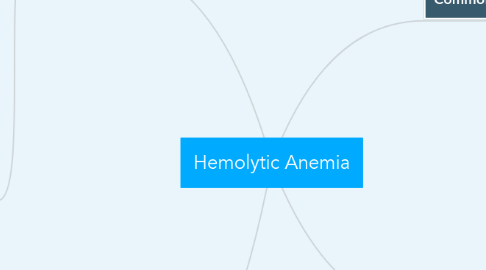
1. Etiology
1.1. Risk Factors
1.1.1. Blood transfusion
1.1.2. Use of Hemolytic Anemia-causing medications
1.1.3. Family history of Hemolytic Anemia
1.2. Causative Factors
1.2.1. Acquired
1.2.1.1. transfusion reactions
1.2.1.2. disease in fetus or newborn
1.2.1.3. warm or cold autoimmune hemolytic anemia
1.2.1.4. drug-induced immune hemolytic anemia
1.2.1.5. bite from insects, snakes, and spiders
1.2.1.6. bacterial or viral infection
1.2.2. Congenital
1.2.2.1. sickle cell disease
1.2.2.2. thalassemia
1.2.2.3. hemoglobin defects
1.2.2.4. hereditary spherocytosis
1.2.2.5. hereditary elliptocytosis
1.2.2.6. paroxysmal nocturnal hemoglobinuria
1.3. Pathophysiologic factors
1.3.1. Non-immune
1.3.1.1. Injury causes destruction of erythrocytes
1.3.1.2. microangiopathic hemolytic anemia
1.3.1.3. Infection from virus or bacteria
1.3.1.4. drug-induced hemolysis
1.3.2. Immune
1.3.2.1. Antibodies cause phagocytosis or complement-mediated destruction
2. Diagnostic Tests
2.1. bone marrow studies and blood tests
2.2. reticulocytosis
2.3. increased lactate dehydrogenase
2.4. increased unconjugated bilirubin
2.5. decreased haptoglobin levels
2.6. Direct antiglobulin test (DAT)
2.6.1. immune cause
2.6.2. nonimmune cause

